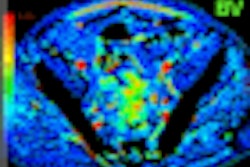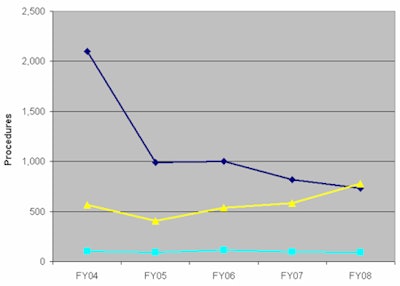
The national grassroots awareness campaign to reduce radiation dose exposure to children -- especially regarding CT exams -- is working, at least at two of the largest academic children's hospitals in the U.S. Children's Hospital of Philadelphia and Cincinnati Children's Hospital Medical Center reported that the volume of CT procedures performed by the hospitals has declined in the past two years, even as overall imaging volumes steadily increased.
When administrators of the radiology departments at each hospital independently noticed some interesting trends related to procedure volume, they decided to evaluate statistics over a five-year period from fiscal years 2003 through 2007 by modality, and share their findings. Kevin Gessner, assistant vice president of Cincinnati Children's Hospital's radiology department, and Chris Tomlinson, director of radiology at Children's Hospital of Philadelphia, wanted to determine what was unexpectedly driving CT volumes down, while ultrasound volumes were exceeding expectations. They speculated that education on the radiation risks of CT examinations was influencing the trend.
"The national media has publicized the risk of radiation exposure to children from CT exams since 2001. Significant efforts have been made to educate referring physicians and the public on radiation risks of CT procedures," Gessner told attendees at a 2008 RSNA scientific session on pediatric dose reduction.
"We knew that our overall imaging volumes were increasing each year. We decided to take a look at the statistics for CT, MRI, and ultrasound exam volumes to determine if nonradiation-emitting modalities, specifically MRI and ultrasound procedures, are being ordered in lieu of CT exams," he said. "We also decided to analyze subspecialty referral patterns."
Statistics from both hospitals were combined and evaluated for the entire five-year period, for a three-year period from fiscal years 2005 through 2007, and for the most recent two years, fiscal years 2006 and 2007. Total volume annualized growth rate was consistent at 5.6% for all five years.
The annualized growth rate was largest for MRI exams during the five-year period, at 9.9%, followed by ultrasound procedures at 9.2%. By comparison, the five-year annualized growth rate for CT exams was only 1.7%. In fact, it declined by 1% in the three-year period analyzed and by 3.5% for the two most recent fiscal years.
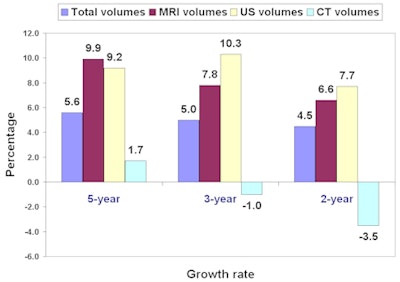 |
| Percentage volume growth of CT, MRI, and ultrasound procedures at Cincinnati Children's Hospital Medical Center and Children's Hospital of Philadelphia. Data courtesy of the radiology departments of both hospitals. |
Gessner noted that during the time period analyzed, both hospitals were undergoing significant radiology department and hospital growth. "Diagnostic imaging services at both hospitals were expanding during this time. We did not factor our procedure capacity into our analysis because we did not want our analysis to be too complex, but if we had, the difference between actual CT modality utilization and CT exam throughput capacity would have been significant," he said.
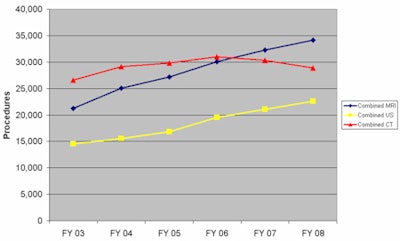 |
| MRI, US, and CT volumes at Cincinnati Children's Hospital Medical Center and Children's Hospital of Philadelphia. Blue line = combined MRI, yellow line = combined ultrasound, and red line = combined CT. Image courtesy of the radiology departments of both hospitals. |
"To better understand the decline in CT exams, we investigated subspecialty referral patterns," Gessner said. "We looked at all subspecialties, but in particular focused on our largest sources of CT referrals. In particular, we evaluated referrals by community pediatricians and general surgery at Cincinnati Children's Hospital, and referrals by ear/nose/throat specialists at Children's Hospital of Philadelphia. Both hospitals evaluated referrals by emergency department physicians."
Emergency department CT orders at Children's Hospital of Philadelphia dropped dramatically, from a high of approximately 2,100 exams in 2004 to approximately 1,000 the following year, and to approximately 750 in 2007. The reduction in CT exams has been less dramatic at Cincinnati Children's Hospital, with a reduction of about 250 procedures between a high of approximately 1,850 exams in the middle of 2006 to 1,600 in the middle of 2008.
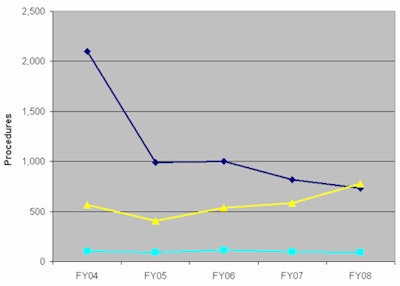 |
| Above, Children's Hospital of Philadelphia emergency medicine CT, MR, and ultrasound referrals. Blue line = CT emergency medicine, aqua line = MR emergency medicine, and yellow line = ultrasound emergency medicine. Below, Cincinnati Children's Hospital Medical Center emergency medicine CT and ultrasound referrals. Blue line = CT emergency medicine, yellow line = ultrasound emergency medicine. Images courtesy of the radiology departments of both hospitals. |
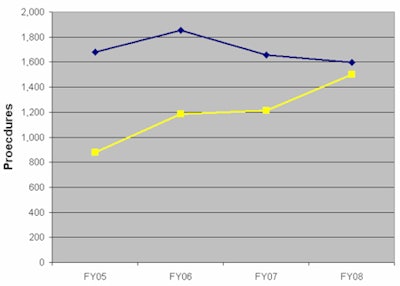 |
Over this time frame, the number of ultrasound procedures ordered by emergency physicians at Cincinnati Children's Hospital almost doubled, from approximately 850 exams in 2005 to 1,500 in the middle of 2008. By comparison, the utilization of emergency ultrasound exams at Children's Hospital of Philadelphia was relatively consistent at approximately 500 exams, only starting to measurably increase to 750 exams in 2007.
Referral patterns of pediatricians requesting CT procedures between mid-2005 and mid-2008 at Cincinnati Children's Hospital held steady at approximately 1,500 procedures, but requests for ultrasound climbed steadily, from approximately 3,700 procedures in mid-2005 to approximately 4,600 procedures in mid-2008.
"Surgeons are clearly requesting ultrasound whenever possible in lieu of CT," Gessner reported. "Usage has soared at our hospital, from approximately 800 procedures in mid-fiscal year 2005 to 2,500 in mid-fiscal year 2008, and we expect this volume growth to continue." Requests for CT exams are showing a less dramatic but steady decline, from a high of 1,500 procedures in 2006 to about 1,250 procedures in mid-2008.
At Children's Hospital of Philadelphia, ear, nose, and throat specialists have significantly reduced the number of CT procedures requested, from 725 in 2004 to 375 in 2007, with a continuing decline in the first half of 2008. MRI procedures requested have increased steadily, from approximately 150 in 2004 to 320 in 2007.
"Although we did not survey our physician community who ordered CT, MRI, and ultrasound exams during these years to determine if radiation dose influenced their decisions, we speculate and conclude that these trends are a result of increased education about radiation risks of CT imaging in children," Gessner said.
By Cynthia Keen
AuntMinnie.com staff writer
December 12, 2008
Related Reading
Swiss pediatric CT survey leads to national dose standards, October 23, 2008
Study: Radiologists dial back on pediatric CT settings, October 4, 2008
CT experts grapple with rising concerns about radiation dose, May 14, 2008
Groups advocate less radiation for kids, January 23, 2008
Teaching parents about CT risk might pare unnecessary scans in kids, December 28. 2006
Copyright © 2008 AuntMinnie.com






